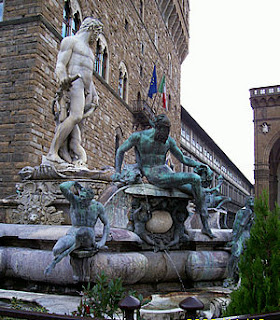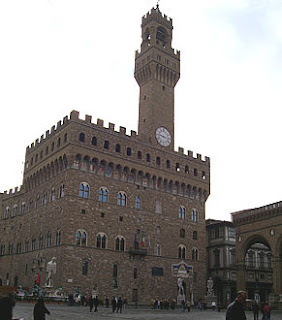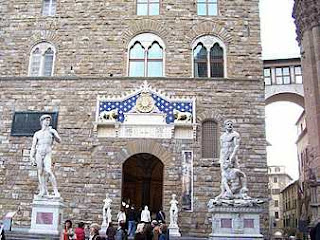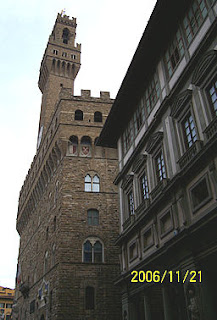
On Sunday morning, 19 November 2006, we walked from our hotel near the central station all the way to the Piazza della Signoria. We spent some time there looking at the Palazzo Vecchio, the Neptune Fountain, the Loggia dei Lanzi, and the outside of the Uffizi Gallery. All of these marvels are to be found side by side on this piazza.

The Neptune Fountain is quite elaborate, and the longer you look at it, the more you discover. These amazing "sea horses" actually have lower bodies like those of fish. The marble statue of Neptune was sculpted by Bartolomeo Ammannati (1575). He took Grand Duke Cosimo I as model for Neptune's face. When the work on the ungainly sea god was finished, Michelangelo scoffed at Ammanati that he had ruined a beautiful piece of marble. The bronze statues which decorate the fountain (satyrs, tritons and nereids) are the work of the Flemish artist Jean de Boulogne.

Here is the Palazzo Vecchio with Neptune's Fountain at the left corner of the building. The Palazzo Vecchio is the town hall of Florence. This massive gothic, crenellated fortress-palace is among the most impressive town halls of Tuscany. Overlooking the Piazza della Signoria with its famous David statue as well the gallery of statues in the adjacent Loggia dei Lanzi, it is one of the most significant public places in Italy.

Originally called the Palazzo della Signoria, it served as the home of Cosimo I de' Medici from 1540 to 1550, who had the palace enlarged to fit the delicate tastes of the grand-ducal court.
The name was officially changed after Cosimo moved to the Pitti Palace, renaming his former palace the Palazzo Vecchio, the "Old Palace", although the adjacent town square, the Piazza della Signoria, still bears the old name. Cosimo I also moved the seat of government to the Uffizi.

The palace gained new importance as seat of United Italy's provisional government from 1865-71, at a moment that Florence had become the capital of the kingdom of Italy.
Although most of the Palazzo Vecchio is now a museum, it remains the symbol of local government and still houses, since 1872, the office of the mayor of Florence and is the seat of the City Council.

No comments:
Post a Comment